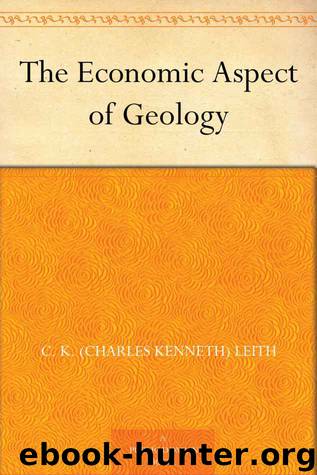The Economic Aspect of Geology by C. K. (Charles Kenneth) Leith

Author:C. K. (Charles Kenneth) Leith [Leith, C. K. (Charles Kenneth)]
Language: eng
Format: epub
Tags: Geology, Economic
Published: 2011-03-24T04:00:00+00:00
Geologic Features
The principal gold mineral is native or metallic gold. This occurs in nature in small scales, crystals, and irregular masses, and also in microscopic particles mechanically mixed with pyrite and other sulphides. Chemically, gold is very inactive and combines with but few other elements. A small part of the world's supply is obtained from the gold-silver tellurides—calaverite, sylvanite, krennerite, and petzite.
Gold deposits are of two general classes—placers, and veins or lodes.
Placers, which are in general the more easily discovered and more easily worked deposits, have in the past been the chief source of the world's gold supply. It is estimated that in the first twenty-seven years of the modern era of gold-mining, beginning with the discovery of gold in California in 1848, 87 per cent of the world's production was obtained from placers. At present the placers of recent geologic age supply a tenth to a fifth of the gold, and ancient or fossil placers in the Transvaal supply another two-fifths. In the United States about a fourth of the gold production comes from placers, mainly from California and Alaska.
Placers are detrital or fragmental sediments containing the ore in mechanical fragments, which are derived from the erosion and transportation of solid-rock veins or lodes, sometimes called the "mother lode." During the process of transportation and deposition there is more or less sorting, because of differing density of the mineral fragments, resulting in the segregation or concentration of the ore minerals in certain layers or channels. Gold, because of its weight, tends to work down toward bedrock, or into scoured or excavated portions of stream channels. In a few cases it is carried in some quantity to the sea and concentrated in beach sands. The processes are not unlike the mechanical concentration of ores by crushing and water sorting. Seldom, however, do the processes go far enough in nature to produce an ore which can be used directly without some further mechanical sorting. Ore minerals concentrated in placers are those which resist abrasion and chemical solution during the processes of weathering and transportation, and which have a density sufficiently high so that they are partially sorted out and concentrated from the accompanying quartz and other minerals. To warrant their recovery they must also be of such high intrinsic value that it pays to mine small quantities. The most important of such minerals are gold, tin, platinum, and the precious stones. Iron, copper, lead, and zinc minerals are often somewhat concentrated as placers, but their intrinsic value is not high enough to warrant the attempt to recover them in the large amounts necessary to make them commercially available.
Placers are forming now and have formed at all stages of the earth's history. Early placers may be reworked and further concentrated by renewal of the proper erosional and transportational conditions. Old placers may be buried beneath younger rocks, cemented, and more or less recrystallized. "Fossil" placers of this kind are best represented by deposits in the Black Hills of South Dakota and probably by the South African gold deposits.
Download
This site does not store any files on its server. We only index and link to content provided by other sites. Please contact the content providers to delete copyright contents if any and email us, we'll remove relevant links or contents immediately.
The Art of Coaching Workbook by Elena Aguilar(50989)
Trainspotting by Irvine Welsh(21519)
Twilight of the Idols With the Antichrist and Ecce Homo by Friedrich Nietzsche(18503)
Fangirl by Rainbow Rowell(9096)
Periodization Training for Sports by Tudor Bompa(8170)
Change Your Questions, Change Your Life by Marilee Adams(7635)
This Is How You Lose Her by Junot Diaz(6794)
Asking the Right Questions: A Guide to Critical Thinking by M. Neil Browne & Stuart M. Keeley(5635)
Grit by Angela Duckworth(5523)
Red Sparrow by Jason Matthews(5390)
Paper Towns by Green John(5089)
Room 212 by Kate Stewart(5037)
Ken Follett - World without end by Ken Follett(4645)
Housekeeping by Marilynne Robinson(4347)
The Sports Rules Book by Human Kinetics(4294)
Double Down (Diary of a Wimpy Kid Book 11) by Jeff Kinney(4207)
Papillon (English) by Henri Charrière(4195)
The Motorcycle Diaries by Ernesto Che Guevara(4012)
Exercise Technique Manual for Resistance Training by National Strength & Conditioning Association(3956)
